Dream comes true for Parish Community
Bob Reddy – Florida Catholic
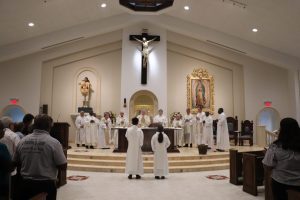 A Church building, dating from the ancient times, has been given the name – the Temple of the Lord. Because of this, a dedication of a new Parish Church permanently makes the building a sacred and holy place where the faithful come to hear the Word of God, to pray together, to celebrate and receive the Sacraments, and most precisely to celebrate often the Eucharist at the Table of the Lord.
A Church building, dating from the ancient times, has been given the name – the Temple of the Lord. Because of this, a dedication of a new Parish Church permanently makes the building a sacred and holy place where the faithful come to hear the Word of God, to pray together, to celebrate and receive the Sacraments, and most precisely to celebrate often the Eucharist at the Table of the Lord.
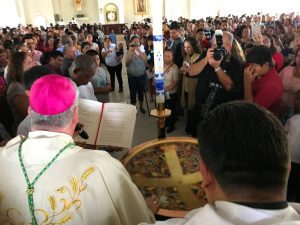 A Church, as a building, is destined solely and permanently for the gathering of the faithful to give Glory and Praise to God, Bishop Frank J. Dewane stressed when he dedicated the new Our Lady of Guadalupe Parish Church during a Mass on July 20 in Immokalee before a joyous assemblage of several thousand.
A Church, as a building, is destined solely and permanently for the gathering of the faithful to give Glory and Praise to God, Bishop Frank J. Dewane stressed when he dedicated the new Our Lady of Guadalupe Parish Church during a Mass on July 20 in Immokalee before a joyous assemblage of several thousand.
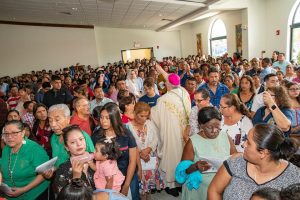 A huge and enthusiastic throng of people were there to witness the next chapter in the life of their beloved Parish. While the Church is a visible building, Bishop Dewane said it is nothing without the faith-filled people of Immokalee. “You are the ‘living stones.’ You are the why we build this Church – to come to gather as a community to adore Christ… It fills my heart with joy to see so many here for this important moment.”
A huge and enthusiastic throng of people were there to witness the next chapter in the life of their beloved Parish. While the Church is a visible building, Bishop Dewane said it is nothing without the faith-filled people of Immokalee. “You are the ‘living stones.’ You are the why we build this Church – to come to gather as a community to adore Christ… It fills my heart with joy to see so many here for this important moment.”
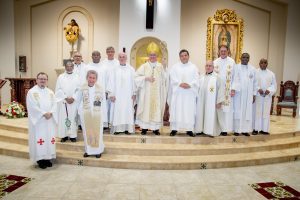 Fittingly, the dedication began in the old church, which was built in 30 years ago, in 1989. Present for the dedication were Our Lady of Guadalupe Pastor Father Carlos Reyes-Ramirez, CS, Missionaries of St. Charles (Scalabrinians), Parochial Vicars Father Wilner Durosier, CS, and Thobias Sariar, M.o.C., as well as Father Moacir Balen, CS, Regional Provincial Superior of the Scalabrinians, and priests from the Diocese, the religious order. A special concelebrant was Father Isaia Birollo, CS, who served at Our Lady of Guadalupe for four years and was present for the 1989 dedication of the old church. “It is amazing how this community has grown. Wonderful!”
Fittingly, the dedication began in the old church, which was built in 30 years ago, in 1989. Present for the dedication were Our Lady of Guadalupe Pastor Father Carlos Reyes-Ramirez, CS, Missionaries of St. Charles (Scalabrinians), Parochial Vicars Father Wilner Durosier, CS, and Thobias Sariar, M.o.C., as well as Father Moacir Balen, CS, Regional Provincial Superior of the Scalabrinians, and priests from the Diocese, the religious order. A special concelebrant was Father Isaia Birollo, CS, who served at Our Lady of Guadalupe for four years and was present for the 1989 dedication of the old church. “It is amazing how this community has grown. Wonderful!”
 Led by the cross bearer, the priests and Bishop then processed to the front doors of the new, but empty church. There the building was symbolically handed over to the Bishop and he said: “Enter the gates of the Lord with thanksgiving, his courts with song and praise.” Pastor Father Reyes then opened the door and all entered.
Led by the cross bearer, the priests and Bishop then processed to the front doors of the new, but empty church. There the building was symbolically handed over to the Bishop and he said: “Enter the gates of the Lord with thanksgiving, his courts with song and praise.” Pastor Father Reyes then opened the door and all entered.
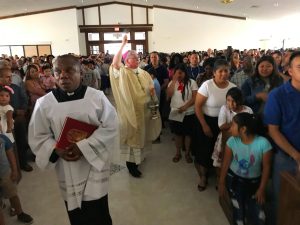 During his homily, Bishop Dewane explained the different parts of the Rite of Dedication, but he also reemphasized the purpose behind the new church by citing the Gospel of Matthew (16:13-19), which was proclaimed during the Mass. In Matthew, Jesus questions the disciples about who other people say He is. When their answers are unsatisfactory, Jesus challenges Peter, “Who do you say that I am?” The Bishop noted that each one of those present answers that question by the life that they live.
During his homily, Bishop Dewane explained the different parts of the Rite of Dedication, but he also reemphasized the purpose behind the new church by citing the Gospel of Matthew (16:13-19), which was proclaimed during the Mass. In Matthew, Jesus questions the disciples about who other people say He is. When their answers are unsatisfactory, Jesus challenges Peter, “Who do you say that I am?” The Bishop noted that each one of those present answers that question by the life that they live.
“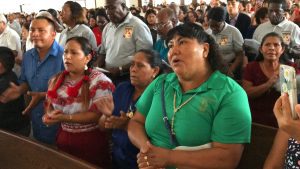 Here in Immokalee, we set about to build this new Church so that every one of you can answer that question,” Bishop Dewane continued. “It is not just for the Fathers to answer it, or for those who are here often… We put up this Church so that no one will have the chance to say: ‘Let someone else enter there.’ Let it be – in this Church of Our Lady of Guadalupe – where everyone begins their response to the Lord of ‘Who do you say that I am?’ and they end with their response by carrying the Lord with them throughout their daily life.”
Here in Immokalee, we set about to build this new Church so that every one of you can answer that question,” Bishop Dewane continued. “It is not just for the Fathers to answer it, or for those who are here often… We put up this Church so that no one will have the chance to say: ‘Let someone else enter there.’ Let it be – in this Church of Our Lady of Guadalupe – where everyone begins their response to the Lord of ‘Who do you say that I am?’ and they end with their response by carrying the Lord with them throughout their daily life.”
Reactions and post-dedication celebration
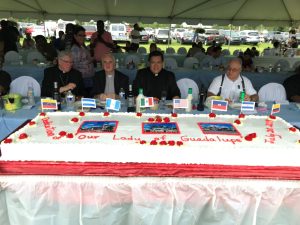 Yolanda Medina brought her young children, Daniela, 6, Elena, 4, and Jose, 3, Manuel, 2, into the new church following the dedication and pointed out the key interior features. These included the crucifix, the tabernacle, the baptismal font, the statue of St. Juan Diego, the image of Our Lady of Guadalupe and a statue of St. Michael the Archangel.
Yolanda Medina brought her young children, Daniela, 6, Elena, 4, and Jose, 3, Manuel, 2, into the new church following the dedication and pointed out the key interior features. These included the crucifix, the tabernacle, the baptismal font, the statue of St. Juan Diego, the image of Our Lady of Guadalupe and a statue of St. Michael the Archangel.
The Medina family first knelt in the pews and prayed for a time before exploring their new Parish Church. “They were in such awe of the whole dedication and wanted to see everything up close. It was amazing to have the Bishop here because we know he helped us build this beautiful place. This is a day Immokalee won’t soon forget.”
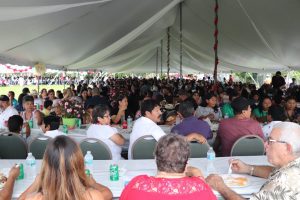 This may be an understatement as the new nearly 15,000-square-foot church, which seats nearly 1,200 comfortable was overflowing out the doors and into the parking lot. Everyone wanted to be present for this historic moment in the life of Our Lady of Guadalupe Parish.
This may be an understatement as the new nearly 15,000-square-foot church, which seats nearly 1,200 comfortable was overflowing out the doors and into the parking lot. Everyone wanted to be present for this historic moment in the life of Our Lady of Guadalupe Parish.
 Tents were set up in a field on the back of the Parish property, seating 3,500 for a post-dedication fiesta complete with food, performances by musicians and dancers as well as a huge cake. There were so many people that some were content to participate standing up. Cooking of the food began about 6 a.m. and the menu include barbeque chicken, pork, rice and beans as well as cake. While it rained off and on during the Mass and the fiesta, no one complained as the celebration lasted well into the evening.
Tents were set up in a field on the back of the Parish property, seating 3,500 for a post-dedication fiesta complete with food, performances by musicians and dancers as well as a huge cake. There were so many people that some were content to participate standing up. Cooking of the food began about 6 a.m. and the menu include barbeque chicken, pork, rice and beans as well as cake. While it rained off and on during the Mass and the fiesta, no one complained as the celebration lasted well into the evening.
The Rite of Dedication
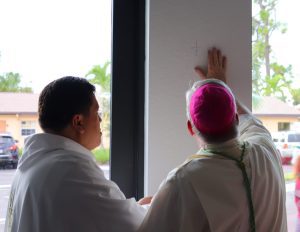 Following the opening procession and entrance into the empty church, the faithful followed and the next part of the Rite began with the Bishop blessing the water in the Baptismal Font, and then he, along with Father Reyes, blessed the people with Holy Water further as a symbol of the spiritual temple of the Lord so as to recall their Baptismal promises. This was followed by the sprinkling of the walls of the Church, marking the Church as a holy place from that day forward — before finally blessing the altar and the sanctuary.
Following the opening procession and entrance into the empty church, the faithful followed and the next part of the Rite began with the Bishop blessing the water in the Baptismal Font, and then he, along with Father Reyes, blessed the people with Holy Water further as a symbol of the spiritual temple of the Lord so as to recall their Baptismal promises. This was followed by the sprinkling of the walls of the Church, marking the Church as a holy place from that day forward — before finally blessing the altar and the sanctuary.
 The Mass then proceeded with some minor adjustments, such as the Litany of Saints replacing the general intercessions. Following the Litany, the rites of anointing, incensing, covering and lighting the altar followed. During the anointing, Bishop Dewane spread Sacred Chrism Oil – blessed at the Chrism Mass during Holy Week – first on the altar and then in the sign of the cross at four points on the walls of the Church. This is done to mark, through sacred designation, the altar and Church. Next was the incensation, symbolic of the “prayers rising up to the Lord, not just for today, but for generations to come” of the altar and then of the nave of the Church.
The Mass then proceeded with some minor adjustments, such as the Litany of Saints replacing the general intercessions. Following the Litany, the rites of anointing, incensing, covering and lighting the altar followed. During the anointing, Bishop Dewane spread Sacred Chrism Oil – blessed at the Chrism Mass during Holy Week – first on the altar and then in the sign of the cross at four points on the walls of the Church. This is done to mark, through sacred designation, the altar and Church. Next was the incensation, symbolic of the “prayers rising up to the Lord, not just for today, but for generations to come” of the altar and then of the nave of the Church.
 Next was the lighting of the altar and the Church. Bishop presented Father Reyes with a lighted candle, who then proceed to light the candles on the newly anointed altar while the lights of the building were turned on. With the Rite concluded, the Holy Sacrifice of the Mass continued.
Next was the lighting of the altar and the Church. Bishop presented Father Reyes with a lighted candle, who then proceed to light the candles on the newly anointed altar while the lights of the building were turned on. With the Rite concluded, the Holy Sacrifice of the Mass continued.
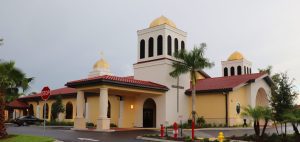 At the end of the Mass, Scalabrinian Provincial Father Balen read a congratulatory letter from the Superior of the Order in Rome to the Parish which included his gratitude to the Bishop and faithful for their continued support to the religious order. Father Reyes also expressed his gratitude to Bishop Dewane for helping to make a reality the long-held dream for a new Church.
At the end of the Mass, Scalabrinian Provincial Father Balen read a congratulatory letter from the Superior of the Order in Rome to the Parish which included his gratitude to the Bishop and faithful for their continued support to the religious order. Father Reyes also expressed his gratitude to Bishop Dewane for helping to make a reality the long-held dream for a new Church.
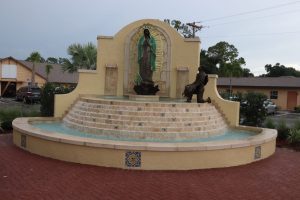 It was in January 2017 when Bishop Dewane and Father Reyes used an excavator to start the work of clearing space for the new Church. Unforeseen delays, plus Hurricane Irma made the project take much longer than anticipated.
It was in January 2017 when Bishop Dewane and Father Reyes used an excavator to start the work of clearing space for the new Church. Unforeseen delays, plus Hurricane Irma made the project take much longer than anticipated.
Bishop Dewane thanked the faithful for their patience during the delays. “I know everyone would agree that it was worth the wait.” A large roar of approval and applause responded to this statement.
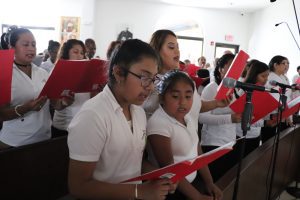 The new church doubles the size of the old building while utilizing masonry and metal in its design. Features include a drive-through porte-cochere and exterior fountain with a shrine to Our Lady of Guadalupe.
The new church doubles the size of the old building while utilizing masonry and metal in its design. Features include a drive-through porte-cochere and exterior fountain with a shrine to Our Lady of Guadalupe.
Following Mass, Bishop Dewane blessed the neighboring 5,000-square-foot Father Richard Sanders Pastoral Center which features eight meeting rooms. The existing Church will eventually be converted into a Parish Hall.
Contractors
Architect: Patrick M. Pillot Architect, Inc.;
Civil Engineer, Spectrum Engineering, Inc., engineer: R. J. (Buck) Ward;
Contractor: Anderson & Ellis, Inc., owner: Steve Anderson, project superintendent: John Augeri;
Exterior Fountain: Jackson Pools, Inc., owner: Tom Fritz;
Pew manufacturer: Imperial Woodworks, Inc., contact: Michael Correa;
Interior designer: KDL Interior Design, LLC, designer: Kristin Lyons;
Church bells: The Verdin Company.
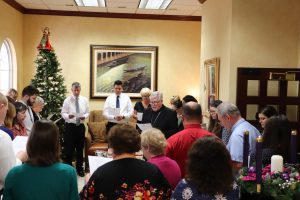 Bishop Frank J. Dewane led a prayer service for the staff of the Catholic Center in Venice on Dec. 1. The prayer service included the blessing of the Advent Candle, Christmas Tree and Nativity scene which will be on display in the lobby throughout Advent.
Bishop Frank J. Dewane led a prayer service for the staff of the Catholic Center in Venice on Dec. 1. The prayer service included the blessing of the Advent Candle, Christmas Tree and Nativity scene which will be on display in the lobby throughout Advent.
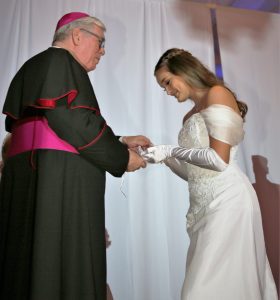 The Mother Frances de Sales Auxiliary to the Homeless held its Fourth Rose Ball Nov. 30 at the Naples Grande Beach Hotel and Resort where 22 young ladies were recognized for their commitment of volunteer service and formation. The event benefited four organizations in Collier County that work to help break the cycle of homelessness. Bishop Frank J. Dewane presented each young lady with a silver Rose Ball medallion of the organizations’ patron, Mother Frances de Sales, known as St. Leonie Aviat, who was canonized on Nov. 25, 2001. The ladies, known as Rose Girls, committed to a two-and-a-half-year volunteer and personal formation program where they make pledges of dignity, charity, and purity and were presented to those gathered as Dignified Ladies of Volunteer Service.
The Mother Frances de Sales Auxiliary to the Homeless held its Fourth Rose Ball Nov. 30 at the Naples Grande Beach Hotel and Resort where 22 young ladies were recognized for their commitment of volunteer service and formation. The event benefited four organizations in Collier County that work to help break the cycle of homelessness. Bishop Frank J. Dewane presented each young lady with a silver Rose Ball medallion of the organizations’ patron, Mother Frances de Sales, known as St. Leonie Aviat, who was canonized on Nov. 25, 2001. The ladies, known as Rose Girls, committed to a two-and-a-half-year volunteer and personal formation program where they make pledges of dignity, charity, and purity and were presented to those gathered as Dignified Ladies of Volunteer Service.

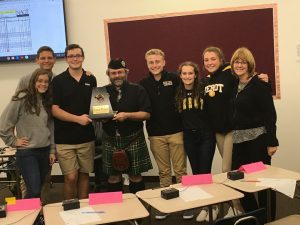






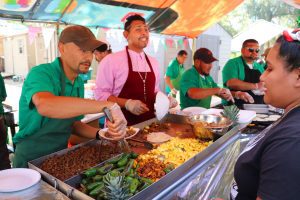 The annual festival is a celebration of both the individual nations and the unified culture of a diverse people. Held annually in early November, the day includes musical performances, ethnic dancers and food from many nations. Throughout the parish grounds were tents full of a wide variety of food that left many mouths watering.
The annual festival is a celebration of both the individual nations and the unified culture of a diverse people. Held annually in early November, the day includes musical performances, ethnic dancers and food from many nations. Throughout the parish grounds were tents full of a wide variety of food that left many mouths watering.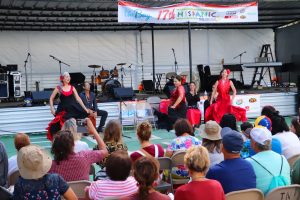 Father Celestino Gutierrez, Pastor of St. Jude, officially opened the Hispanic Festival with a prayer. This followed a “Parade of Flags” when each country represented at the festival was announced, and the respective flags brought forward to cheers from the crowd.
Father Celestino Gutierrez, Pastor of St. Jude, officially opened the Hispanic Festival with a prayer. This followed a “Parade of Flags” when each country represented at the festival was announced, and the respective flags brought forward to cheers from the crowd. Thousands attend the event annually from as far away as Naples and Clearwater. It has become a much-anticipated event for the ethnically diverse Sarasota Parish. All of the proceeds of the Hispanic Festival go to support the various outreach efforts of the Parish, including helping countless families throughout the year.
Thousands attend the event annually from as far away as Naples and Clearwater. It has become a much-anticipated event for the ethnically diverse Sarasota Parish. All of the proceeds of the Hispanic Festival go to support the various outreach efforts of the Parish, including helping countless families throughout the year.


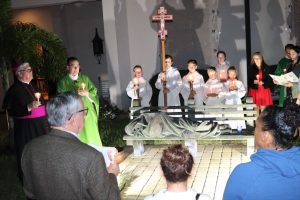
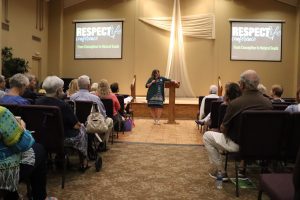 Father Kantor added that while not many were able to attend the 2019 state conference in St. Augustine, the local conference was able to reach out to more in the parish and serve as a compliment for the efforts of Respect Life in the Catholic Church in the Diocese of Venice in hope and unity with the society and the world.
Father Kantor added that while not many were able to attend the 2019 state conference in St. Augustine, the local conference was able to reach out to more in the parish and serve as a compliment for the efforts of Respect Life in the Catholic Church in the Diocese of Venice in hope and unity with the society and the world.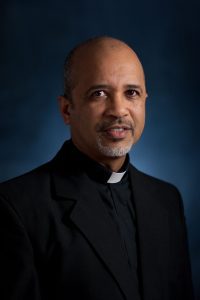

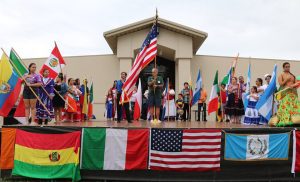

 Representatives of the San Marco Knights of Columbus Assembly 2514 presented a check for $2,000 in October to Collier Lee Honor Flight. Collier Lee Honor Flight was established in 2013, its mission is to transport veterans from Collier and Lee counties to Washington, DC to visit the memorials dedicated to honor their service and sacrifices. A typical mission will visit the World War II Memorial, Korean War Memorial, Vietnam Veterans Memorial, Air Force Memorial, Marine Corps Memorial, and Arlington Cemetery. Top priority is given to World War II and Korean War era veterans, and to any veteran of any war that has a terminal illness. Veterans travel by a chartered commercial jet, and police escorted buses while on the ground. A typical mission will have 70 to 75 veterans. Trips are provided at no cost to the veterans.
Representatives of the San Marco Knights of Columbus Assembly 2514 presented a check for $2,000 in October to Collier Lee Honor Flight. Collier Lee Honor Flight was established in 2013, its mission is to transport veterans from Collier and Lee counties to Washington, DC to visit the memorials dedicated to honor their service and sacrifices. A typical mission will visit the World War II Memorial, Korean War Memorial, Vietnam Veterans Memorial, Air Force Memorial, Marine Corps Memorial, and Arlington Cemetery. Top priority is given to World War II and Korean War era veterans, and to any veteran of any war that has a terminal illness. Veterans travel by a chartered commercial jet, and police escorted buses while on the ground. A typical mission will have 70 to 75 veterans. Trips are provided at no cost to the veterans.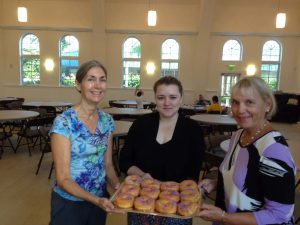
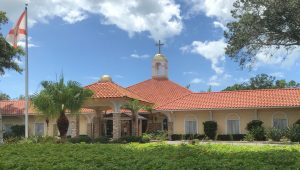 In preparation for Hurricane Dorian, the Diocese of Venice Hurricane Committee met daily as the monster storm loomed in the Caribbean Sea and menaced Florida with some early forecasts ominously aiming directly at Southwest Florida with impacts as early as Sunday, Sept. 1. This committee included leaders of Catholic Charities, which would have led the post-disaster humanitarian response.
In preparation for Hurricane Dorian, the Diocese of Venice Hurricane Committee met daily as the monster storm loomed in the Caribbean Sea and menaced Florida with some early forecasts ominously aiming directly at Southwest Florida with impacts as early as Sunday, Sept. 1. This committee included leaders of Catholic Charities, which would have led the post-disaster humanitarian response.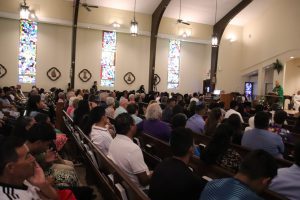 Sacred Heart Parish, near downtown Bradenton, has a history to fondly look back upon that dates to 1888. However, it wasn’t until 81 years later, June 4, 1969 to be exact, that the actual Parish was permanently erected as an off-shoot of St. Joseph Parish.
Sacred Heart Parish, near downtown Bradenton, has a history to fondly look back upon that dates to 1888. However, it wasn’t until 81 years later, June 4, 1969 to be exact, that the actual Parish was permanently erected as an off-shoot of St. Joseph Parish. A Church building, dating from the ancient times, has been given the name – the Temple of the Lord. Because of this, a dedication of a new Parish Church permanently makes the building a sacred and holy place where the faithful come to hear the Word of God, to pray together, to celebrate and receive the Sacraments, and most precisely to celebrate often the Eucharist at the Table of the Lord.
A Church building, dating from the ancient times, has been given the name – the Temple of the Lord. Because of this, a dedication of a new Parish Church permanently makes the building a sacred and holy place where the faithful come to hear the Word of God, to pray together, to celebrate and receive the Sacraments, and most precisely to celebrate often the Eucharist at the Table of the Lord. A Church, as a building, is destined solely and permanently for the gathering of the faithful to give Glory and Praise to God, Bishop Frank J. Dewane stressed when he dedicated the new Our Lady of Guadalupe Parish Church during a Mass on July 20 in Immokalee before a joyous assemblage of several thousand.
A Church, as a building, is destined solely and permanently for the gathering of the faithful to give Glory and Praise to God, Bishop Frank J. Dewane stressed when he dedicated the new Our Lady of Guadalupe Parish Church during a Mass on July 20 in Immokalee before a joyous assemblage of several thousand. A huge and enthusiastic throng of people were there to witness the next chapter in the life of their beloved Parish. While the Church is a visible building, Bishop Dewane said it is nothing without the faith-filled people of Immokalee. “You are the ‘living stones.’ You are the why we build this Church – to come to gather as a community to adore Christ… It fills my heart with joy to see so many here for this important moment.”
A huge and enthusiastic throng of people were there to witness the next chapter in the life of their beloved Parish. While the Church is a visible building, Bishop Dewane said it is nothing without the faith-filled people of Immokalee. “You are the ‘living stones.’ You are the why we build this Church – to come to gather as a community to adore Christ… It fills my heart with joy to see so many here for this important moment.” Fittingly, the dedication began in the old church, which was built in 30 years ago, in 1989. Present for the dedication were Our Lady of Guadalupe Pastor Father Carlos Reyes-Ramirez, CS, Missionaries of St. Charles (Scalabrinians), Parochial Vicars Father Wilner Durosier, CS, and Thobias Sariar, M.o.C., as well as Father Moacir Balen, CS, Regional Provincial Superior of the Scalabrinians, and priests from the Diocese, the religious order. A special concelebrant was Father Isaia Birollo, CS, who served at Our Lady of Guadalupe for four years and was present for the 1989 dedication of the old church. “It is amazing how this community has grown. Wonderful!”
Fittingly, the dedication began in the old church, which was built in 30 years ago, in 1989. Present for the dedication were Our Lady of Guadalupe Pastor Father Carlos Reyes-Ramirez, CS, Missionaries of St. Charles (Scalabrinians), Parochial Vicars Father Wilner Durosier, CS, and Thobias Sariar, M.o.C., as well as Father Moacir Balen, CS, Regional Provincial Superior of the Scalabrinians, and priests from the Diocese, the religious order. A special concelebrant was Father Isaia Birollo, CS, who served at Our Lady of Guadalupe for four years and was present for the 1989 dedication of the old church. “It is amazing how this community has grown. Wonderful!” Led by the cross bearer, the priests and Bishop then processed to the front doors of the new, but empty church. There the building was symbolically handed over to the Bishop and he said: “Enter the gates of the Lord with thanksgiving, his courts with song and praise.” Pastor Father Reyes then opened the door and all entered.
Led by the cross bearer, the priests and Bishop then processed to the front doors of the new, but empty church. There the building was symbolically handed over to the Bishop and he said: “Enter the gates of the Lord with thanksgiving, his courts with song and praise.” Pastor Father Reyes then opened the door and all entered. During his homily, Bishop Dewane explained the different parts of the Rite of Dedication, but he also reemphasized the purpose behind the new church by citing the Gospel of Matthew (16:13-19), which was proclaimed during the Mass. In Matthew, Jesus questions the disciples about who other people say He is. When their answers are unsatisfactory, Jesus challenges Peter, “Who do you say that I am?” The Bishop noted that each one of those present answers that question by the life that they live.
During his homily, Bishop Dewane explained the different parts of the Rite of Dedication, but he also reemphasized the purpose behind the new church by citing the Gospel of Matthew (16:13-19), which was proclaimed during the Mass. In Matthew, Jesus questions the disciples about who other people say He is. When their answers are unsatisfactory, Jesus challenges Peter, “Who do you say that I am?” The Bishop noted that each one of those present answers that question by the life that they live. Here in Immokalee, we set about to build this new Church so that every one of you can answer that question,” Bishop Dewane continued. “It is not just for the Fathers to answer it, or for those who are here often… We put up this Church so that no one will have the chance to say: ‘Let someone else enter there.’ Let it be – in this Church of Our Lady of Guadalupe – where everyone begins their response to the Lord of ‘Who do you say that I am?’ and they end with their response by carrying the Lord with them throughout their daily life.”
Here in Immokalee, we set about to build this new Church so that every one of you can answer that question,” Bishop Dewane continued. “It is not just for the Fathers to answer it, or for those who are here often… We put up this Church so that no one will have the chance to say: ‘Let someone else enter there.’ Let it be – in this Church of Our Lady of Guadalupe – where everyone begins their response to the Lord of ‘Who do you say that I am?’ and they end with their response by carrying the Lord with them throughout their daily life.” Yolanda Medina brought her young children, Daniela, 6, Elena, 4, and Jose, 3, Manuel, 2, into the new church following the dedication and pointed out the key interior features. These included the crucifix, the tabernacle, the baptismal font, the statue of St. Juan Diego, the image of Our Lady of Guadalupe and a statue of St. Michael the Archangel.
Yolanda Medina brought her young children, Daniela, 6, Elena, 4, and Jose, 3, Manuel, 2, into the new church following the dedication and pointed out the key interior features. These included the crucifix, the tabernacle, the baptismal font, the statue of St. Juan Diego, the image of Our Lady of Guadalupe and a statue of St. Michael the Archangel. This may be an understatement as the new nearly 15,000-square-foot church, which seats nearly 1,200 comfortable was overflowing out the doors and into the parking lot. Everyone wanted to be present for this historic moment in the life of Our Lady of Guadalupe Parish.
This may be an understatement as the new nearly 15,000-square-foot church, which seats nearly 1,200 comfortable was overflowing out the doors and into the parking lot. Everyone wanted to be present for this historic moment in the life of Our Lady of Guadalupe Parish. Tents were set up in a field on the back of the Parish property, seating 3,500 for a post-dedication fiesta complete with food, performances by musicians and dancers as well as a huge cake. There were so many people that some were content to participate standing up. Cooking of the food began about 6 a.m. and the menu include barbeque chicken, pork, rice and beans as well as cake. While it rained off and on during the Mass and the fiesta, no one complained as the celebration lasted well into the evening.
Tents were set up in a field on the back of the Parish property, seating 3,500 for a post-dedication fiesta complete with food, performances by musicians and dancers as well as a huge cake. There were so many people that some were content to participate standing up. Cooking of the food began about 6 a.m. and the menu include barbeque chicken, pork, rice and beans as well as cake. While it rained off and on during the Mass and the fiesta, no one complained as the celebration lasted well into the evening. Following the opening procession and entrance into the empty church, the faithful followed and the next part of the Rite began with the Bishop blessing the water in the Baptismal Font, and then he, along with Father Reyes, blessed the people with Holy Water further as a symbol of the spiritual temple of the Lord so as to recall their Baptismal promises. This was followed by the sprinkling of the walls of the Church, marking the Church as a holy place from that day forward — before finally blessing the altar and the sanctuary.
Following the opening procession and entrance into the empty church, the faithful followed and the next part of the Rite began with the Bishop blessing the water in the Baptismal Font, and then he, along with Father Reyes, blessed the people with Holy Water further as a symbol of the spiritual temple of the Lord so as to recall their Baptismal promises. This was followed by the sprinkling of the walls of the Church, marking the Church as a holy place from that day forward — before finally blessing the altar and the sanctuary. The Mass then proceeded with some minor adjustments, such as the Litany of Saints replacing the general intercessions. Following the Litany, the rites of anointing, incensing, covering and lighting the altar followed. During the anointing, Bishop Dewane spread Sacred Chrism Oil – blessed at the Chrism Mass during Holy Week – first on the altar and then in the sign of the cross at four points on the walls of the Church. This is done to mark, through sacred designation, the altar and Church. Next was the incensation, symbolic of the “prayers rising up to the Lord, not just for today, but for generations to come” of the altar and then of the nave of the Church.
The Mass then proceeded with some minor adjustments, such as the Litany of Saints replacing the general intercessions. Following the Litany, the rites of anointing, incensing, covering and lighting the altar followed. During the anointing, Bishop Dewane spread Sacred Chrism Oil – blessed at the Chrism Mass during Holy Week – first on the altar and then in the sign of the cross at four points on the walls of the Church. This is done to mark, through sacred designation, the altar and Church. Next was the incensation, symbolic of the “prayers rising up to the Lord, not just for today, but for generations to come” of the altar and then of the nave of the Church. Next was the lighting of the altar and the Church. Bishop presented Father Reyes with a lighted candle, who then proceed to light the candles on the newly anointed altar while the lights of the building were turned on. With the Rite concluded, the Holy Sacrifice of the Mass continued.
Next was the lighting of the altar and the Church. Bishop presented Father Reyes with a lighted candle, who then proceed to light the candles on the newly anointed altar while the lights of the building were turned on. With the Rite concluded, the Holy Sacrifice of the Mass continued. At the end of the Mass, Scalabrinian Provincial Father Balen read a congratulatory letter from the Superior of the Order in Rome to the Parish which included his gratitude to the Bishop and faithful for their continued support to the religious order. Father Reyes also expressed his gratitude to Bishop Dewane for helping to make a reality the long-held dream for a new Church.
At the end of the Mass, Scalabrinian Provincial Father Balen read a congratulatory letter from the Superior of the Order in Rome to the Parish which included his gratitude to the Bishop and faithful for their continued support to the religious order. Father Reyes also expressed his gratitude to Bishop Dewane for helping to make a reality the long-held dream for a new Church. It was in January 2017 when Bishop Dewane and Father Reyes used an excavator to start the work of clearing space for the new Church. Unforeseen delays, plus Hurricane Irma made the project take much longer than anticipated.
It was in January 2017 when Bishop Dewane and Father Reyes used an excavator to start the work of clearing space for the new Church. Unforeseen delays, plus Hurricane Irma made the project take much longer than anticipated. The new church doubles the size of the old building while utilizing masonry and metal in its design. Features include a drive-through porte-cochere and exterior fountain with a shrine to Our Lady of Guadalupe.
The new church doubles the size of the old building while utilizing masonry and metal in its design. Features include a drive-through porte-cochere and exterior fountain with a shrine to Our Lady of Guadalupe.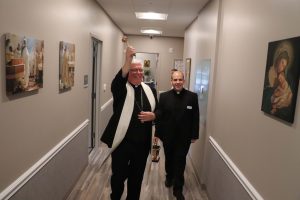 The celebration was a culmination of a nearly 10 years plan to upgrade the Parish facilities and this project coincided with an urgent need because of damage from 2017’s Hurricane Irma.
The celebration was a culmination of a nearly 10 years plan to upgrade the Parish facilities and this project coincided with an urgent need because of damage from 2017’s Hurricane Irma.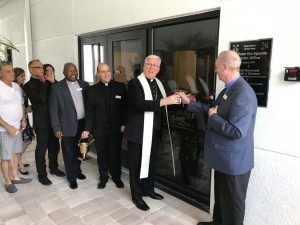 Bishop Dewane and Father Gerard “G” Critch, Pastor of St. Peter the Apostle, made the first official cut of the ribbon. The other priests, deacons and members of the building committee also cut and then received small commemorative pieces of ribbon.
Bishop Dewane and Father Gerard “G” Critch, Pastor of St. Peter the Apostle, made the first official cut of the ribbon. The other priests, deacons and members of the building committee also cut and then received small commemorative pieces of ribbon.